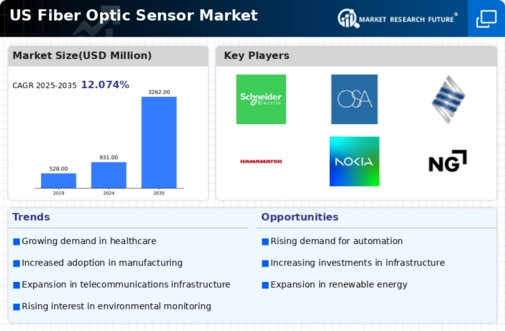Advancements in Industrial Automation
The fiber optic-sensor market is significantly influenced by advancements in industrial automation. As manufacturing processes become increasingly automated, the demand for precise and reliable sensing solutions rises. Fiber optic sensors offer advantages such as immunity to electromagnetic interference and the ability to operate in harsh environments, making them ideal for industrial applications. The market for these sensors is expected to reach $1 billion by 2027, driven by their integration into automated systems for monitoring and control. Industries such as oil and gas, automotive, and aerospace are particularly keen on adopting these technologies to enhance safety and efficiency. The ongoing trend towards Industry 4.0 further emphasizes the importance of fiber optic sensors in achieving seamless connectivity and data exchange within automated environments.
Increased Investment in Renewable Energy
The fiber optic-sensor market is benefiting from increased investment in renewable energy sources. As the shift towards sustainable energy solutions accelerates, the demand for monitoring systems that ensure efficiency and safety in renewable energy installations rises. Fiber optic sensors are utilized in wind turbines and solar panels to monitor performance and detect potential issues. The renewable energy sector is expected to attract over $500 billion in investments by 2030, creating substantial opportunities for the fiber optic-sensor market. These sensors play a crucial role in optimizing energy production and minimizing downtime, which is essential for the economic viability of renewable projects. The growing emphasis on sustainability and energy efficiency is likely to drive further adoption of fiber optic technologies in this sector.
Enhanced Safety Regulations in Transportation
The fiber optic-sensor market is increasingly shaped by enhanced safety regulations in the transportation sector. As governments and regulatory bodies impose stricter safety standards, the demand for advanced monitoring solutions rises. Fiber optic sensors are employed in various transportation applications, including railways and highways, to monitor structural integrity and detect potential hazards. The market is projected to grow by 12% annually as transportation authorities seek to improve safety and reduce accidents. The ability of fiber optic sensors to provide real-time data on critical parameters enhances decision-making and response times in emergency situations. This trend underscores the importance of integrating advanced sensing technologies into transportation infrastructure to ensure compliance with safety regulations and protect public welfare.
Growing Focus on Structural Health Monitoring
The fiber optic-sensor market is witnessing growth due to an increasing focus on structural health monitoring (SHM) in various infrastructure projects. As aging infrastructure poses risks, the need for continuous monitoring of structural integrity has become paramount. Fiber optic sensors provide real-time data on stress, strain, and temperature, enabling timely maintenance and reducing the likelihood of catastrophic failures. The market for SHM is projected to grow at a CAGR of 15% through 2030, indicating a robust demand for fiber optic solutions. This trend is particularly relevant in the context of bridges, dams, and buildings, where safety and longevity are critical. The integration of fiber optic sensors into SHM systems not only enhances safety but also optimizes maintenance schedules, ultimately leading to cost savings and improved asset management.
Rising Demand for High-Speed Data Transmission
The fiber optic-sensor market is experiencing a surge in demand driven by the need for high-speed data transmission across various sectors. As industries increasingly rely on real-time data analytics, the adoption of fiber optic sensors becomes crucial. These sensors facilitate faster communication and data transfer, which is essential for applications in telecommunications and data centers. The market is projected to grow at a CAGR of approximately 10% over the next five years, reflecting the escalating need for efficient data handling. This trend is particularly evident in urban areas where smart city initiatives are being implemented, further propelling the fiber optic-sensor market. The integration of these sensors into existing infrastructure is likely to enhance operational efficiency and reduce latency, making them indispensable in modern communication networks.





















Leave a Comment